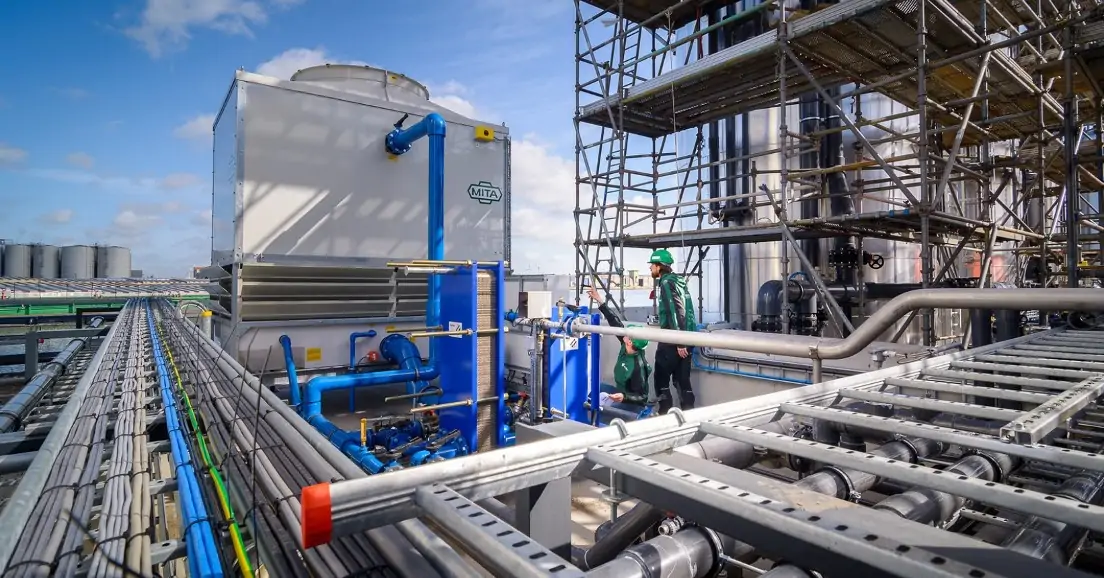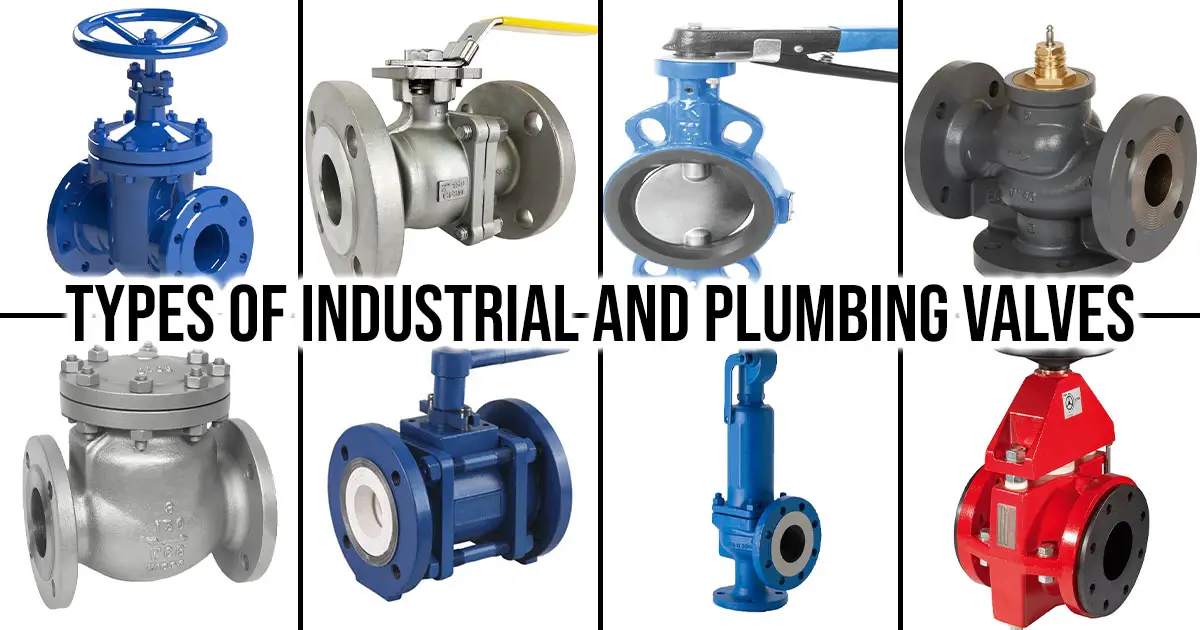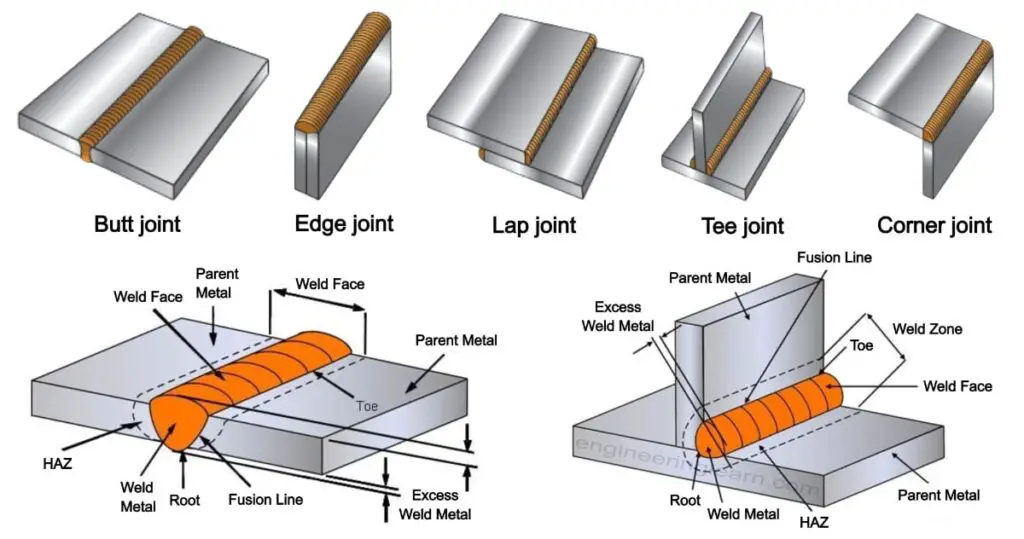What is a Cooling Tower?
The cooling tower is a critical component of a power plant’s cooling system. The cooling tower’s basic working principle is atmospheric air to cool the hot water. Despite this, it is widely employed in various engineering fields and other refrigeration facilities.
The cooling tower in a thermal power plant rises at least 9 feet above the ground. The cooling tower’s base is surrounded by a water storage unit known as a “pond.”After the condenser releases hot water, the cooling tower collects it at a certain height and then sprays it down in a radial motion. The bottom of the tower is where the cooler, ambient air enters.
The cooling tower’s hot air is now exposed to the outside air, which lowers the temperature of the hot water through partial evaporation. The cooled water is collected at the tower’s base and pumped into the condenser for further use. A small amount of water can be reused repeatedly in this manner. This power plant uses a cooling tower when the water supply is limited.
A cooling tower’s ability to cool water is dependent on several factors, including:
- The cooling tower’s diameter and height.
- The air’s relative humidity.
- The air’s temperature.
- The cooling tower’s air entry velocity.
- The cooling tower’s plate arrangement.
- All parts of the cooling tower have easy access to fresh air.
How Does a Cooling Tower Work?
Nozzles attached to the hot water pipe spray the fills (heat exchanging surfaces) to distribute the hot water from power plants or industries. The hexagonal cavities on the fills allow the spreading water to move slowly downward, preventing it from clogging.
The air from the bottom of the cooling tower rises, passing through the fills, and then exits the tower. When hot water and air come into contact, the air cools the water by absorbing the water’s latent heat. The air has absorbed the heat from the water, making it hotter, and the evaporation of some of the water cools water even more.
It’s well known that evaporation has a cooling effect, which means that the surfaces from which the evaporation occurs cool down. After the hot water has been cooled, the vaporizing water is carried upward by the rising air. You can see it above the hot water pipe. The drift eliminator cools most of the water vapor, which keeps it from escaping the cooling tower.
A very small amount of water vapor might be able to get out. The cooling tower’s drift eliminator allows the heated air to escape. Drift elimination is necessary to minimize cooling tower water loss; the temperature of the water drops as it descends through the fills and reaches the basin at the end.
The cold water from the basin is then returned to the condensers of the power plant and other industrial machinery for cooling purposes. Water is moved around inside and outside the cooling towers with the help of centrifugal pumps.
Types of Cooling Towers:
1. Atmospheric Cooling Towers:
It is the most basic kind of cooling tower. It comprises a rectangular chamber with louvered walls on one end. The louvers are devices that act as a barrier to splashing out and sunlight. They also direct the flow of wind. The amount of atmospheric air that enters the cooling tower is determined by the speed of the wind guided by the louvers.
The tower is filled with fill material, on which air and water come into contact. The tower’s capacity varies from 50 to 100 liters per minute per square meter of the base area, depending upon the air velocity. They are inexpensive but inefficient because their performance is heavily influenced by wind velocity and direction.
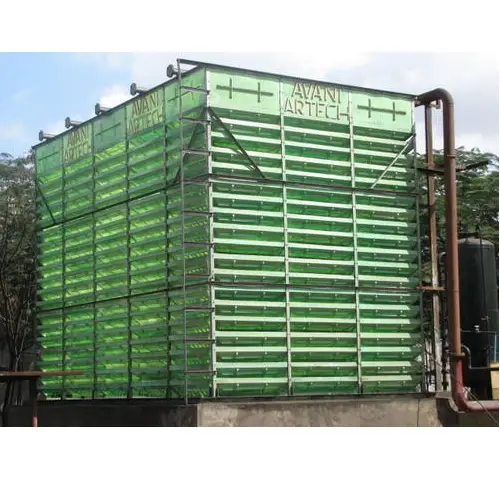
Courtesy: chemicalengineering.com
Atmospheric Cooling Towers Usages:
Atmospheric cooling tower uses in power plants, chemical plants, and air cooling plants
Pros of Atmospheric Cooling Towers:
Atmospheric cooling towers do not use a mechanical fan to move air through the tower; a pressure spray provides a natural induction flow.
Cons of Atmospheric Cooling Towers:
It is not used for high-capacity thermal plants as the cooling range is limited, wind losses are high, and there is no control over the outlet temperature of the water.
2. Natural Draft Cooling Towers:
To cool the water, it uses a heat exchanger that lets it come into contact with fresh air. Within the cooling tower, jets of hot water are used to maximize cooling efficiency while also increasing the surface area for heat transfer. It raises the temperature and the humidity of the air within the tower. Water at the bottom collects colder air, rising to the tower’s top.
Natural draft cooling towers supply fresh air at the bottom, which takes advantage of the density difference between hot air at the top and ambient air outside. By way of the chimney effect in the cooling tower’s design, a natural pressure difference is created, resulting in airflow. Because warm and moist air is less dense than colder air, it rises out of a cooling tower and draws in denser fresh air from the surrounding area.
The temperature difference inside and outside the cooling tower creates the ideal airflow. The height of the cooling tower is calculated using a specific mathematical formula to ensure that it is nearly as large as the density difference. Therefore, cooling towers utilizing this system are typically quite large, reaching 200 meters and spanning widths of 150 meters.
The towers also have a lot of water flowing through them. A concrete shell with a hyperbolic form is the most common material for the shell itself. The natural draught cooling tower is the ideal solution when operating in cold, humid climates with high winter loads.

Courtesy: hamon.com
Natural Draft Cooling Towers Usages:
Natural draft cooling towers are commonly used in power plants but are also found in energy-intensive facilities such as oil refineries, petrochemical plants, and natural gas plants.
Pros of Natural Draft Cooling Towers:
- Because no electrical fan is installed, power is saved.
- Maintenance costs are low.
- There are no corrosion issues.
- Because of the high stack outlet, there is no recirculation of air.
Cons of Natural Draft Cooling Towers:
- Large amounts of water must be pumped into a natural draft cooling tower.
- Many of these require a large amount of space.
- Wind speed and direction affect its performance.
3. Mechanical Draft Cooling Towers:
The mechanical draught cooling towers are very similar to the natural draught cooling towers in terms of their design and operation. The air in this cooling tower is circulated using a fan or blower. There are a few differences between this and a natural draught. In mechanical draught towers, propeller fans or centrifugal fans are the most common types of fans.

Courtesy: enexio.com
Mechanical Draft Cooling Tower Usages:
It is the most common type of cooling tower in buildings and uses power-driven fans to draw or force air through it. In most cases, they can be found on the street or in a nearby park.
Pros of Mechanical Draft Cooling Towers:
- Mechanical draught cooling towers are much more compact than natural draft cooling towers for the same capacity used in each. It is due to the fan’s increased air volume forcing out more coolant, which increases cooling capacity.
- In a mechanical draught cooling tower, capacity can be controlled. The air volume can be controlled by adjusting the fan’s speed, affecting capacity.
- Mechanical draft cooling towers can be installed inside the building,
Cons of Mechanical Draft Cooling Towers:
- It takes a lot of power to run the system.
- The cost of maintaining the system’s fans, motors, and other components has increased.
4. Forced Draft Cooling Towers:
A fan is used to move air through such a cooling tower. It takes a lot of cold water to run a power plant at full capacity. A 1000 rpm motor spins the fan in any direction you want it to go. The working principle is similar to that of a natural draught cooling tower, except the fan is located on the cooling tower.
Tower-mounted cooling fans are most commonly used for installations of large capacity and require a large capacity fan to operate effectively. As a result, the fan in a forced draught cooling tower is mounted horizontally, while in an induced draught cooling tower, the fan is mounted vertically on top of the cooling tower.
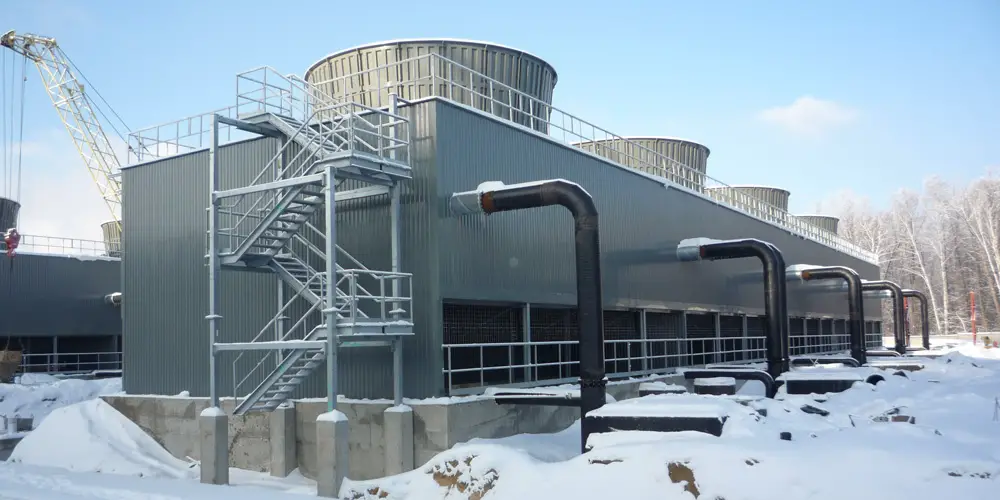
Courtesy: fansct.com
Forced Draft Cooling Towers Usages:
Forced draft cooling towers are used in the paper and chemical industries.
Pros of Forced Draft Cooling Towers:
- It is simple to generate turbulence, which helps in heat transfer.
- Lower operating costs.
- The tube bundle can be checked and repaired from the upper part, making the operation simple.
Cons of Forced Draft Cooling Towers:
The most significant drawback of a forced draught cooling tower is the potential for exhaust air recirculation. Increased inlet air saturation reduces the tower’s efficiency when circulated.
5. Induced Draft Cooling Towers:
Unlike forced draught towers, which cause air to recirculate, induced draught towers use a mechanical device to accomplish this. Induced draught cooling towers have fans located at the top of the tower. The bottom of the tower is where the air inlet is located. When a fan runs, the suction at the bottom of the tower moves the air.
It will take more power to move air in a process using a counter flow mechanism because liquid exiting the packing creates the greatest resistance to air entry. It is possible to operate induced draught towers in concurrent, counter-current, and cross-flow modes.

Courtesy: towertechindia.com
Induced Draft Cooling Towers Usages:
Induced draft cooling towers are commonly used in dry steam power plants and industries.
Pros of Induced Draft Cooling Towers:
- Since the driest air is brought into contact with the ice coldest water, this method has many advantages.
- The diameter can be as large as 20 meters.
- The lower initial cost is due to the smaller pump capacity and shorter water pipes.
Cons of Induced Draft Cooling Towers:
- Compared to a forced draught fan with the same air-water flow, this fan requires a more powerful motor.
- The air velocity distribution through the packings is not uniform.
6. Cross Flow Cooling Towers:
Cross flow cooling towers have their fill arranged so that hot process water flows vertically down the fill media due to gravity, while air blows horizontally across the falling water to cool it. It’s for this reason that this design’s naming scheme was chosen. In this design for cross-flow cooling towers, gravity is all that is required for water to flow down the fill to reach the cold water basin because there is no opposing force. Cross-flow hot water from a cooling tower covers the tops of the hot water basins above the fills. It makes sure that the hot water is spread out evenly.
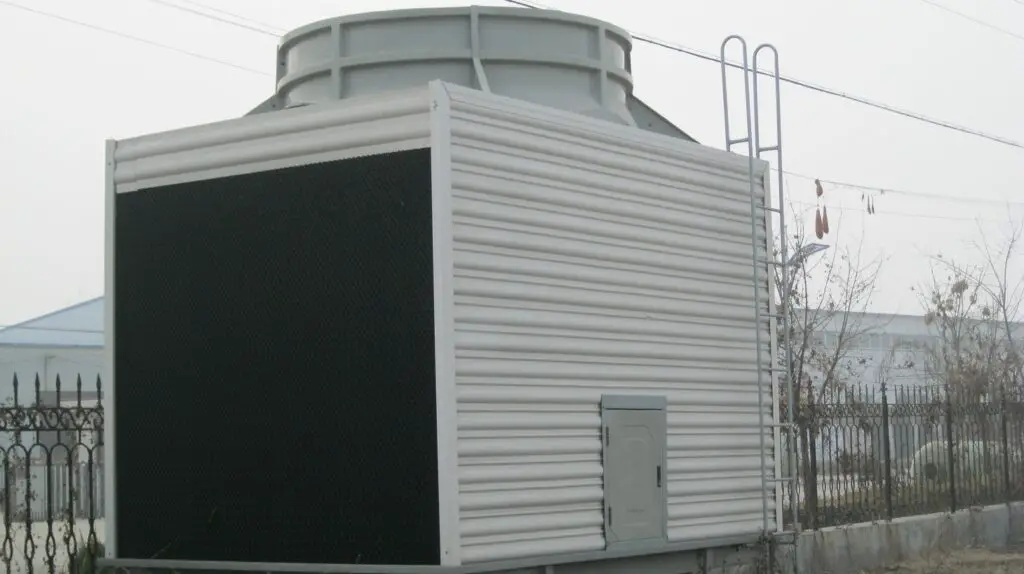
Courtesy: bitrebels.com
Cross Flow Cooling Tower Usages:
The cross-flow cooling tower is best suited for all types of industrial work. As a result of the towers’ modest size, this can be done quickly. They can be easily adapted to meet the requirements of a particular industry.
Pros of Cross Flow Cooling Tower:
- A low pumping head means lower pumping costs at the outset.
- Water distribution systems can withstand greater fluctuations in water flow without harm.
- Reduced operating and energy costs
- Static pressure drop is very low.
- Distribution nozzles are easily accessible for maintenance.
- Make-up has been reduced.
Cons of Cross Flow Cooling Tower:
- Limit of 4 degrees Celsius for cooling tower approach
- A larger area to cover.
- In cold weather, the icing of louvers is more difficult to control with a larger area of louvers.
- A spray nozzle with a low-pressure head can lead to orifice clogging and reduced water breakup.
7. Counter Flow Cooling Tower:
The hot process water is sprayed onto the fill media, allowing it to flow vertically down and onto the cold water basin. This time, the air enters the tower at a lower level and flows upwards to cool it down by passing through the water flowing in the fill.
The water brought to the nozzles must be pressurized because air flows in the opposite direction of the water. An additional downward force must be provided to prevent water from back flowing into the nozzles. Compared to cross-flow cooling towers, counter flow cooling tower nozzles are placed further apart to ensure that no air is restricted in the tower.
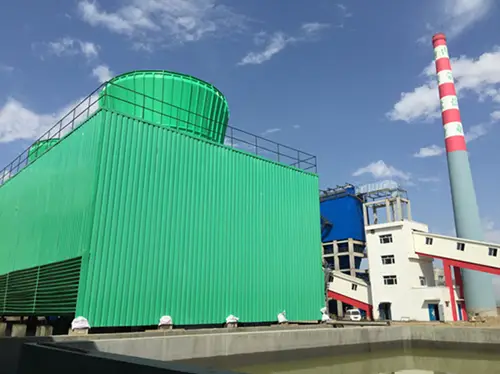
Courtesy: exportersindia.com
Counter Flow Cooling Tower Usages:
Counter flow cooling towers are used in medical plants, nuclear power stations, chemical and oil refineries, thermal power plants, small factory industries, boilers, and furnace plants.
Pros of Counter Flow Cooling Tower:
- Longer ranges and closer approaches are made possible by higher towers.
- Air moving vertically across the fill increases tower performance by bringing the coldest water into contact with the driest air.
- The smaller droplets produced by pressure sprays allow for more effective use of the available air.
Conclusion:
Cooling towers are specialized heat exchangers that generate cooling by bringing water and air into contact instead of the normal conduction – convection heat transfer of shell and tube heat exchangers. Evaporative cooling and sensible heat transfer are used to achieve this cooling. Several types of cooling towers have their own set of benefits and drawbacks.
Cooling tower efficiency is determined by three important factors: the relationship between range and approach, wet-bulb temperature, and cooling load. Water evaporation causes a variety of problems, including scaling and biological fouling. Water blow down, filtration, softening, and chemical addition are all common water treatment methods.

